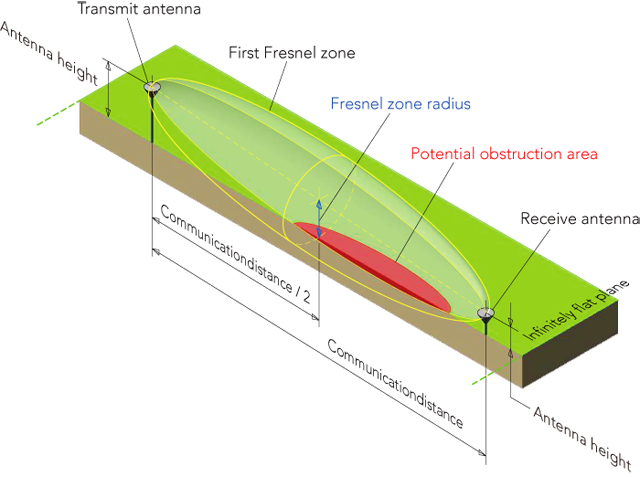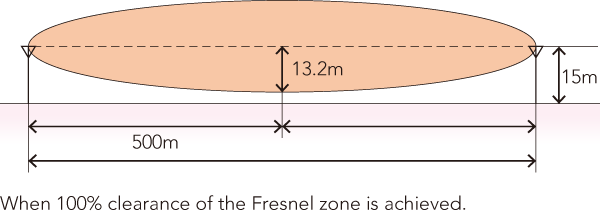Fresnel zone calculation tool
By entering frequency and distance, it is possible to calculate the ideal height of the antenna that takes into account the Fresnel zone and the height of the antenna that is equal to 60% of the Fresnel radius.
❶ Enter the frequency used in MHz
Frequency MHz
❷ Enter the communication distance in meters
Distance m
Ideal height of antenna
Height of antenna that is equal to 60% of the Fresnel radius
What is the Fresnel zone?
Regarding the Fresnel zone, a reference is commonly made to a region (line of sight) where communication is possible. Good line of sight communication does not simply mean having both antennas visible to one another, but refers to the Fresnel zone that is securely established for communication.

The Fresnel zone is an ellipsoidal space that begins with the 1st to 2nd Fresnel zone and extends outwards indefinitely but is mainly characterised by the 1st Fresnel zone. If the conditions are satisfied for the 1st Fresnel zone, this can be considered to be nearly equivalent to radio wave propagation in free space. However this condition can be approximated if clearance of at least 60% of the 1st Fresnel radius is achieved.
For example, transmission at 1000m using 400 MHz, the Fresnel zone radius becomes 13.2m and 60% of this radius would be 7.9m.

In the above the antennas are 15m high, maximum clearance (100%) of the Fresnel zone is achieved.

In the above when the antennas are 3m high, obviously the lower section of the Fresnel zone has not been cleared, this will incur a 6dB transmission loss.
In actuality the Fresnel zone expands left and right as well as up and down so its impact has to be analysed in 3 dimensions.
The Fresnel zone characteristics will vary with frequency and distance. If the frequency is increased (shorter wavelength) or distance is reduced, the Fresnel zone size will decrease.
When designing a communication system, ideally there should be line of sight communication. However this is difficult in practice so installation to achieve this should be done as much as possible. When installing the antenna, in addition to the Fresnel zone the antenna height pattern and other factors should be considered.
Formulas used on this page

1st Fresnel zone
Distance between transmitter and antenna: d(m)
Distance from central axis to zone edge at centre (Fresnel radius): r1(m)
Distance from transmitter to Fresnel radius at centre: d1(m)
Distance from receiver to Fresnel radius at centre: d2(m)
Difference between the radio wave direct and non-direct paths in the Fresnel zone: d3(m)
Wavelength: λ(m)
$$ d3=\sqrt{d1^2+r1^2}+\sqrt{d2^2+r1^2}-d=\frac{\lambda}{2} $$
Therefore, the Fresnel radius anywhere along the zone is:
$$ r1(m)=\sqrt{\lambda\frac{d1d2}{d1+d2}} $$
The Fresnel radius at exactly halfway can be expressed when d1 = d2 = d/2:
$$ r1(m)_{centre} =\frac{\sqrt{\lambda d}}{2} $$